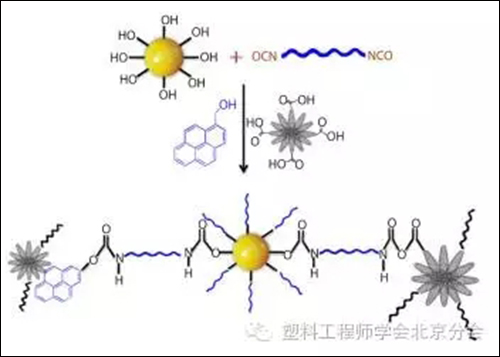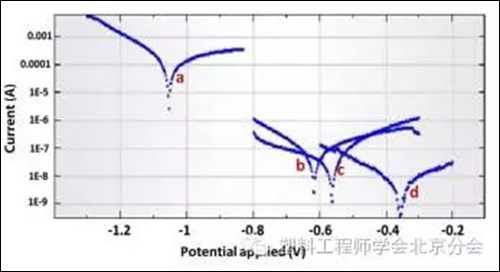一种多功能的合成方法,可用于实现高性能富氮超支化聚合物-碳纳米角复合材料的制备。
近年来,碳在各种工业应用中(例如电子产品、纺织品和涂料),已经成为一种很有前景的材料。事实上,碳在结构方面的分子水平的变化,使得其产生了许多宝贵的同素异形体(每种都具有独特的物理化学性质和热机械性能)。尤其是碳纳米管、碳纳米颗粒以及石墨烯,由于其作为涂料配方的一种良好材料而备受关注。然而,碳粒子在这些涂料中的分散性差,这是一个主要的约束(即不恰当的分散会导致材料中的性能分布不均匀)。
在之前的工作中,我们已经证明,通过碳材料的共价或非共价功能化(其中碳是基本功能部分的装饰)能够解决这个分散问题。在非共价官能化中π-π堆叠是用来添加芳族烃,而功能部分是共价键方法的关注点所在。此外,最近在涂层技术方面有一个很大的进步,使得在单层涂料中变成多功能。这种多功能涂层(例如,包括聚氨酯)是特别有趣,因为聚合物和一系列碳填料之间的相容性。为了改善这种碳填料在聚合物基体内的分散性,支化聚合物系统已被认为是一种。例如,在过去的几十年里,不同支化聚合物体系和用于确定支化程度的表征工具以及计算分子参数的聚合物动力学都得到了发展。此外,这种含有杂原子(如氧、氮、硼、氯)的球状结构的分支聚合物体系,使得高聚物化学易于操作。含氮前驱体材料是易于获得的,并且具有一些有趣的性质(例如,微生物性、腐蚀抑制作用以及良好的附着力)。
因此,在我们最近的工作,我们研究了富氮超支化聚氨酯-碳纳米复合材料系统。我们也使用这种复合材料开发出了一种高性能的多方面的化学涂层。特别是,我们将单壁碳纳米角作为超支化聚氨酯基体中的填充材料,其中这种超支化聚氨酯的支化度达到将近60%。
为了合成我们的超支化聚氨酯基体,我们采用癸二酸作为前体物质,它是蓖麻油的衍生物(即一种自然产生的物质)。我们还采用一种标准的缩聚反应——三个羧基基团和四个羟基基团以及葵二酸发生反应——形成了一个由富氮超支化聚醚多元醇封端的羟基。然后我们的的超支化聚合物与异氰酸酯发生反应,从而形成聚氨酯脲涂层。为了实现碳纳米角在聚氨酯基体中的良好分散,我们在纳米角上进行了荧光芘基团的π-π堆叠。此外,我们还在纳米角表面增加了羧基官能团,从而使得聚氨酯中的(–NCO)基团形成共价键。

图1 碳纳米角-聚氨酯复合材料(CNH-PU)的形成示意图。C:碳。O:氧。H:氢。N:氮。
在我们的研究中,我们也遵循一个独特的策略来将纳米填料添加至聚合物基体中。具体而言,在多羟基化合物与–NCO基团反应时(即形成异氰酸酯联动),我们向体系中添加了碳纳米角和1-芘甲醇(如图1所示)。羧基与–NCO之间形成酰胺键,并且实现非共价功能化。此外,在1-芘甲醇中的羟基形成异氰酸酯,从而提高体系内的交联。因此,我们的复合材料是高度相互关联的体系,包括共价和非共价功能化。

图2 (a)裸露的低碳钢钢板(b) 0% CNH(即纯 PU),(c)0.1% CNH以及 (d) 0.5% CNH的CNH-PU混合涂层的极化测量。在一个3.5%氯化钠溶液中,使用塔菲尔法进行测量。
我们的复合材料的交联氨基甲酸酯段可以被用来在低碳钢(即少量的碳)的表面形成一个阻挡层,从而限制腐蚀性物质的渗透。此外,我们使用的荧光基团为早期的腐蚀检测提供了范围。因此我们进行了一系列实验,从中我们发现,与那些纯聚合物相比,在聚氨酯基体中加入非常小的量的碳纳米角(0.1–0.5%)可以使理化性能与热性能得到巨大的改善(如图2所示)。例如,我们的复合材料具有较高的储能模量(约1081MPa)和较低的腐蚀率(6.16×10-5毫米/年)以及良好的灵活性。
总之,我们开发了一种通用方法,用于实现制备氮核超支化聚合物–碳纳米角复合材料(支化度约为60%)。我们还表明我们的复合材料的特殊存储模量、耐腐蚀性、灵活性和荧光我们的材料性,可作为我们的合成方法成功的证据。像这种涂层在未来可能会发展其他的应用,比如作为荧光探针、分子印迹传感器或作为潮湿环境中腐蚀保护的涂层。在未来的研究中,这将是控制我们聚合物的支化度、化学结构、分子量和多分散性指数所必要的。此外,我们想找一种将杂原子掺杂到聚合物中的更容易的方法(即减少处理步骤)。最后,我们打算将线性和超支化体系结合,从而使我们的合成方法能够进一步突破。
作者信息
Srinivasarao Pilla
Polymers and Functional Materials Division, Indian Institute of Chemical Technology (CSIR)
Srinivasarao Pilla received his master's in chemistry from Andhra University, India, in 2010. He then joined the Polymers and Functional Materials Division at CSIR for his PhD, which he received in 2012 from the Academy of Scientific and Innovative Research (India)。 He subsequently received a junior research fellowship in 2012 and a senior research fellowship in 2014. His current research interests are focused on the fabrication of hyperbranched molecular architectures and nanocomposites, and using biobased materials for the development of high-performance coatings/nanocomposites.
Rohit Ranganathan Gaddam
Polymers and Functional Materials Division, Indian Institute of Chemical Technology (CSIR)
Rohit Ranganathan Gaddam is currently a PhD student at the University of Queensland (Australia), under the supervision of Xiu Zhao and Ashok Nanjundan. He has been awarded International Postgraduate Research and University of Queensland Centennial scholarships for his PhD study. He previously worked at CSIR as a researcher and has conducted work at the Central Glass and Ceramic Research Institute and Central Electrochemical Research Institute (both part of CSIR)。 He holds an MTech in nanotechnology. His research interests are focused on bioderived carbon materials for energy-storage devices.
Ramanuj Narayan
Polymers and Functional Materials Division, Indian Institute of Chemical Technology (CSIR)
Ramanuj Narayan has been a senior scientist at CSIR since 2008. He received his bachelor's degree (1991) from Magadh University, India. He then completed a master's in chemistry (1994) at the University of Delhi, India, and in technology (1996) at the National Institute of Technology, India (with a focus in surface and colloid science)。 He subsequently conducted research on the development of high-solid and water-dispersable coatings at CSIR (under the supervision of Kothapalli Raju) and was awarded a PhD in 2002 from the Indian School of Mines. He has since worked as a research scientist at Aisin Cosmos R&D Co. Ltd, a researcher at R&D Tata Steel Ltd, and a senior scientist in the Composites Division of Tata AutoComp Systems Ltd. His research interests include organic, polymeric, and hybrid materials for functional coatings, composites, and third-generation solar cells.
Kothapalli V. S. N. Raju
Polymers and Functional Materials Division, Indian Institute of Chemical Technology (CSIR)
Kothapalli V. S. N. Raju recived his master's and PhD from Osmania University, India. He then worked in Werner Funke's laboratory in Germany. His current research interests are focused on organic–inorganic hybrids, as well as the functionalization of nanomaterials, hyperbranched polymers, thermoset polymers, and triazole chemistry for the development of functional polymers.
更多关于材料方面、材料腐蚀控制、材料科普等等方面的国内外最新动态,我们网站会不断更新。希望大家一直关注中国腐蚀与防护网http://www.ecorr.org 责任编辑:王元 《中国腐蚀与防护网电子期刊》征订启事
投稿联系:编辑部
电话:010-62313558-806
邮箱:ecorr_org@163.com
中国腐蚀与防护网官方 QQ群:140808414
免责声明:本网站所转载的文字、图片与视频资料版权归原创作者所有,如果涉及侵权,请第一时间联系本网删除。
-
标签: SPE-China, 耐腐蚀涂层, 纳米碳/聚氨酯复合材料, 制备

官方微信
《中国腐蚀与防护网电子期刊》征订启事
- 投稿联系:编辑部
- 电话:010-62316606-806
- 邮箱:fsfhzy666@163.com
- 中国腐蚀与防护网官方QQ群:140808414





